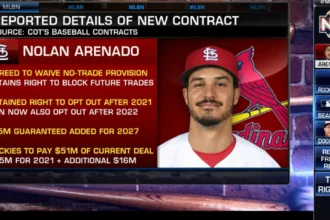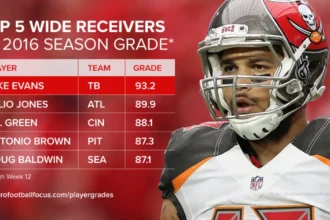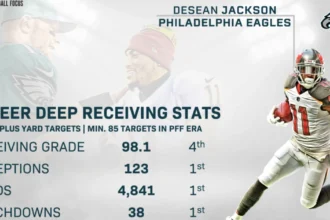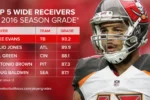Hey there, basketball fans—or maybe you’re just someone who’s heard the name Jeremy Lin and wondered, “Who was that guy?” Either way, welcome to a fun dive into one of the most inspiring stories in NBA history. I’m talking about Jeremy Lin Career Stats, the Taiwanese-American point guard who turned the league upside down with his smarts, hustle, and that unforgettable burst of “Linsanity.” Whether you’re a die-hard hoops junkie or someone sharing this with a kid who’s just discovering the game, I’ll keep things straightforward, like chatting over a pickup game. No jargon overload, just the good stuff: his journey, the numbers that tell his tale, and why his stats aren’t just digits—they’re proof that hard work can rewrite the script.
Picture this: A kid from the Bay Area, overlooked by big colleges, undrafted in the NBA, sleeping on teammates’ couches. Fast forward, and he’s dropping 38 points on Kobe Bryant, leading the Knicks to the playoffs, and sparking a global frenzy. Jeremy’s career wasn’t a straight shot to stardom; it was a zigzag of triumphs, setbacks, and comebacks. By the time he hung up his sneakers in 2025, he’d played for eight NBA teams, won a ring with the Raptors, and left a legacy that’s as much about heart as it is about highlights. Let’s break it down, starting from the beginning.
The Early Days: Building the Foundation at Harvard
Jeremy Shu-How Lin was born on August 23, 1988, in Torrance, California, to Taiwanese immigrant parents who were total basketball nerds. Gie-Ming and Shirley Lin had met at a pickup game in Taipei, and they raised Jeremy and his brother Josh in Palo Alto, where the court was basically an extension of the living room. By high school at Palo Alto High, Jeremy was a three-time all-league player, but scouts saw a 6-foot-3 guard who wasn’t flashy enough for the blue-blood programs. Duke? UNC? Not even a sniff.
Instead, he chose Harvard, an Ivy League school where athletes study as hard as they play. From 2006 to 2010, Jeremy became a Crimson legend. He was the first Ivy player to make the All-Conference first team four years in a row. Defensively, he was a beast—leading the nation in steals as a sophomore with 108 swipes. Offensively, he dished dimes like a pro, averaging 11.3 assists per 40 minutes in his junior year.
His college stats? Solid gold for a guy balancing econ classes and hoops. Over 119 games, he put up 1,483 points (12.5 per game), 487 rebounds (4.1), 406 assists (3.4), and 225 steals (1.9). He shot 46.8% from the field and 33.6% from three. Fun fact: Jeremy graduated with a 3.1 GPA in economics—talk about well-rounded. But the NBA draft in 2010? Crickets. Undrafted. That’s where most stories end. Jeremy’s? That’s where they begin.
Breaking In: The NBA Grind and D-League Detours
Summer leagues became Jeremy’s audition tape. He impressed the Chicago Bulls enough for a free-agent deal, but training camp didn’t pan out. Next stop: Golden State Warriors, his hometown team, on a non-guaranteed contract. He debuted on October 29, 2010—fittingly against the Rockets—and played 29 games as a rookie, mostly garbage time. His stats that year: 2.5 points, 0.3 rebounds, 1.1 assists in 9.8 minutes per game. Shooting? 43.6% from the field, but he showed flashes, like a 10-point, 5-assist night in December.
The Warriors waived him mid-season, and he landed with the L.A. D-Fenders in the D-League (now G League). There, Jeremy exploded: 18.9 points, 5.2 rebounds, 5.2 assists over 20 games. It was a wake-up call—he belonged in the bigs. The Warriors brought him back for the 2011-12 season opener, but after nine games (4.5 PPG), they traded him to save salary. Houston claimed him off waivers, but injuries sidelined him. Then, on December 27, 2011, the New York Knicks signed him to a 10-day contract. Little did anyone know, a phenomenon was about to drop.
Linsanity: The Knicks’ Fairy Tale and Career-High Stats
Ah, Linsanity. If you’ve never heard the term, it’s like Beatlemania but for basketball—and it all happened in February 2012. With the Knicks slumping at 8-15, injuries forced Jeremy into the starting lineup. He didn’t just play; he dominated. Against the Nets? 25 points, 5 rebounds, 7 assists. Lakers? 38 points on Kobe. Warriors? 34 points, including a dagger three. In five starts, he scored 136 points—the most since the ABA-NBA merger.
That month, Jeremy averaged 24.6 points, 8.4 assists, 2.0 rebounds, and 1.8 steals on 51.8% shooting. He became the first player since Magic Johnson to drop 20+ points with 7+ assists in his first five starts. The media frenzy was wild—headlines in China, Taiwan, everywhere. Asian-Americans saw a hero; skeptics saw a fluke. But the stats? Undeniable. For the full 2011-12 season with the Knicks (35 games), he posted 14.6 points, 6.2 assists, 3.1 rebounds, 1.6 steals, shooting 44.6% from the field and 32.0% from deep.
The Knicks made the playoffs, but lost to Miami in five games. Jeremy averaged 17.6 points and 6.8 assists in the postseason—his only deep playoff run at the time. Linsanity peaked, but injuries (chest, knee) nagged him. Still, it changed everything. He signed a three-year, $25 million deal with Houston. From couch surfer to cover boy in months. Classic Jeremy.
The Rollercoaster: Rockets, Lakers, and Beyond
Houston was next, and Jeremy settled in as James Harden’s sidekick. In 2013-14, he averaged 12.5 points and 6.1 assists, career highs in minutes (31.7). He hit 36.4% from three—his best mark. But the Rockets never meshed fully, and after two seasons, they traded him to the Lakers in 2014 for cap relief.
L.A. was tough. Teammates like Kobe and Nash were legends; Jeremy was the bridge. In 2014-15, ankle injuries limited him to 36 games (11.2 PPG, 4.6 APG). The next year? A career-worst 6.6 PPG in 32 games before a hamstring tear. Fans chanted his name, but the purple and gold didn’t shine. Waived again in 2016, he signed with Brooklyn on a bargain deal.
The Nets revived him. In 2016-17, 24.5 minutes yielded 10.0 points and 4.1 assists. He peaked with 38 points on the Kings. But a ruptured patellar tendon in March 2017 sidelined him eight months. Back in 2017-18, he averaged 11.0 points off the bench. Atlanta traded for him mid-season, where he finished strong (12.8 PPG in 42 games).
In 2018-19, Jeremy joined Charlotte as a vet minimum guy. He started 20 games, averaging 7.7 points, but it was clear the league had moved on. Then, a twist: The Toronto Raptors called in the playoffs. He played nine games, averaging 4.2 points, but hoisted the Larry O’Brien Trophy as part of the 2019 champs. No parades for bench guys, but that ring? Priceless.
The Final NBA Chapters and Global Adventures
Post-championship, Jeremy bounced to more teams. Back to Brooklyn in 2019-20 (10.2 PPG in 44 games), then Golden State for a nostalgic 2020-21 stint (4.7 PPG in 21 games). By 2021, the NBA door creaked shut. He headed overseas, joining the Beijing Ducks in China (CBA), where he averaged 20+ points. Then Taiwan’s Fiber Future (now New Taipei Kings) in the P.League+, leading them to the 2025 title with 20.1 points per game.
Why leave? Jeremy said the NBA had “kind of given up on me,” but he kept playing for the love of it—and to rep his heritage. In 2025, at 37, he retired, reflecting on a career that spanned 480 NBA games, a championship, and millions inspired. His international stats? Over 100 games in China and Taiwan: 19.5 PPG, 5.0 APG, proving he could still cook.
Jeremy Lin Career Stats: The Numbers That Inspire
Alright, let’s get to the meat—the stats. I’ve pulled together his full NBA regular-season record from reliable spots like Basketball-Reference and ESPN. These aren’t just columns; they show evolution. Rookie struggles? Check. Linsanity explosion? Double check. Steady vet role? You bet. I’ll present his year-by-year averages in a table first, then totals. Playoff numbers get their own spotlight, because those February-to-June battles tell a different story.
NBA Regular Season Averages (Per Game)
| Season | Team(s) | GP | MPG | PPG | RPG | APG | SPG | BPG | FG% | 3P% | FT% |
|---|---|---|---|---|---|---|---|---|---|---|---|
| 2010-11 | GSW | 29 | 9.8 | 2.5 | 1.2 | 1.1 | 0.6 | 0.0 | 43.6 | 20.0 | 80.0 |
| 2011-12 | NYK/HOU | 37 | 26.6 | 11.7 | 2.8 | 4.9 | 1.3 | 0.1 | 44.0 | 32.9 | 80.0 |
| 2012-13 | HOU | 82 | 32.3 | 13.4 | 3.0 | 6.1 | 1.6 | 0.4 | 43.7 | 35.7 | 80.1 |
| 2013-14 | HOU | 71 | 31.7 | 12.5 | 2.6 | 4.5 | 1.2 | 0.3 | 43.9 | 36.4 | 80.9 |
| 2014-15 | LAL | 36 | 25.0 | 11.2 | 2.2 | 4.6 | 1.0 | 0.3 | 41.9 | 34.0 | 79.2 |
| 2015-16 | LAL | 32 | 18.0 | 6.6 | 1.8 | 1.9 | 0.7 | 0.1 | 38.0 | 30.8 | 73.7 |
| 2016-17 | BKN | 46 | 24.5 | 10.0 | 3.6 | 4.1 | 1.0 | 0.3 | 43.2 | 31.1 | 80.2 |
| 2017-18 | BKN/ATL | 64 | 22.1 | 10.7 | 2.9 | 3.9 | 0.9 | 0.2 | 44.3 | 35.6 | 73.3 |
| 2018-19 | ATL/CHA/TOR | 83 | 15.8 | 7.7 | 1.9 | 2.5 | 0.6 | 0.1 | 42.1 | 32.6 | 81.1 |
| Career | 480 | 24.0 | 11.6 | 2.8 | 4.3 | 1.0 | 0.2 | 43.0 | 33.3 | 78.9 |
Sources: Aggregated from Basketball-Reference and ESPN data.
See that 2012-13 line? 82 games, 13.4 points, 6.1 assists—that’s Jeremy in his prime, a full-season Linsanity echo. Or 2018-19: Down to 15.8 minutes, but still efficient at 42.1% shooting. He adapted, always the floor general.
NBA Regular Season Totals
For the big-picture fans, here’s the cumulative haul over those nine seasons:
| Category | Total |
|---|---|
| Games Played | 480 |
| Minutes | 11,523 |
| Points | 5,574 |
| Rebounds | 1,339 |
| Assists | 2,055 |
| Steals | 507 |
| Blocks | 110 |
| Field Goals Made | 2,080 |
| Three-Pointers Made | 467 |
| Free Throws Made | 947 |
He crossed 5,000 points without ever being an All-Star—talk about underrated. His assist total screams playmaker; those 2,055 dimes set up teammates for glory.
Playoff Stats: When the Lights Get Bright
Jeremy only made the playoffs twice meaningfully, but boy, did he show up. In 2012 with the Knicks (5 games vs. Heat): 17.6 points, 6.8 assists, 3.2 rebounds, 1.8 steals on 45.3% FG. Then 2019 with Toronto (9 games, mostly mop-up): 4.2 points, 1.4 assists in 8.7 minutes. Totals: 14 games, 112 points, 74 assists. Not volume king, but efficient—50.0% FG in ’12. That ring in ’19? The cherry on top.
What the Stats Say: Peaks, Valleys, and Life Lessons
Digging deeper, Jeremy’s numbers paint a portrait of resilience. Career-high single-game: 38 points (twice, vs. Lakers and Cavs). Most assists: 14 (vs. Mavericks in ’12). Rebounds? 12 once, but he wasn’t a board-crusher—his game was vision and speed.
Shooting splits evolved too. Early on, he attacked the rim (80% FT career). Later, threes improved to 36.4% in ’13-14. Turnovers? 2.7 per game career—price of pushing pace. Advanced metrics like PER (Player Efficiency Rating) peaked at 21.0 in ’11-12, above average. Win shares? 18.4 total, meaning he helped teams win about 18 extra games.
But stats miss the intangibles. Jeremy’s steal rate (1.0 SPG) came from IQ—he read plays like a book. His assist-to-turnover ratio (1.6) shows smarts over flash. And post-NBA? In China, he averaged 20.5 PPG in 2021-22; in Taiwan, 19.8 in 2024-25. Global stats: 18.5 PPG, 4.8 APG over 150+ games. He didn’t fade; he thrived.
Injuries stole seasons—over 200 games missed—but he played 83 in his last NBA year at 30. That’s grit. For kids reading this: Jeremy’s 11.6 career PPG isn’t Jordan-level, but it’s real. It says, “Keep shooting, even from the bench.”
Beyond the Numbers: Linsanity’s Lasting Echo
Jeremy Lin Career Stats wasn’t just a player; he was a movement. “Linsanity” boosted Asian-American visibility—jerseys sold out in Taipei, kids in Oakland picked up basketballs. He spoke openly about faith, race (remember the “Chink in the Armor” backlash? He turned it into advocacy), and mental health. Post-retirement in August 2025, after winning Taiwan’s TPBL title, he said, “I’ve given everything to this game. Now, time to give back.









